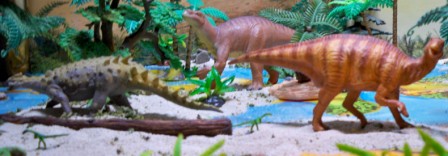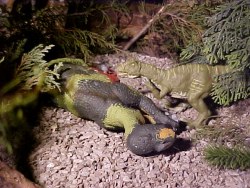Early Cretaceous
During the Mesozoic Australia was at the end of the world, attached to the end of a long peninsula of Gondwanaland. This isolation seems to have allowed older forms like allosaurids and labyrinthidonts to exist when they had become extinct elsewhere. Fossil remains are often very scrappy and several species have been identified based on single bones or even footprints. During the Cretaceous, Australia and Antarctica began to separate, sea levels rose and a large inland sea developed.
updated 110412
Closed forests habitats were common in the temperate climate, and this may account for the small size of the dinosaurs found there. Minmi was named after a location in Australia and was about 10 feet long. This is small for an ankylesaurid and Minmi doesn't seem to belong to either the nodosaur or ankylosaur families. It and the iguanodontid Muttaburrasaurus are two of the best-known Australian dinosaurs coming from relatively complete skeletons.

Muttaburrasaurus,reaching 23 feet long, was a plant eater (possibly an omnivore) and often found in marshy areas. It had an intriguing and unique large bump on its nose, and walked on all fours, although able to stand on its rear legs. It had teeth designed for shearing rather than grinding, and a snout featuring a distinctively expanded hollow chamber, with large external nostrils that may have served as cooling chambers.

 Muttaburrasaurus is referred to as an iguanodontid, but it may be more closely related to Dryosaurus and Tenontosaurus. The thumb spike seems to also be questionable. This plant eater (may also have eaten some meat) was often found in marshy areas. It had an intriguing and unique large bump on its nose. It walked on all fours although it could stand on its rear legs. It had teeth designed for shearing rather than grinding. The snout has a distinctively expanded hollow chamber with large external nostrils that may have served as a cooling chamber.
Muttaburrasaurus is referred to as an iguanodontid, but it may be more closely related to Dryosaurus and Tenontosaurus. The thumb spike seems to also be questionable. This plant eater (may also have eaten some meat) was often found in marshy areas. It had an intriguing and unique large bump on its nose. It walked on all fours although it could stand on its rear legs. It had teeth designed for shearing rather than grinding. The snout has a distinctively expanded hollow chamber with large external nostrils that may have served as a cooling chamber.
 Australia has representatives of several dinosaur families and one large carnosaur an allosaurid. The Australian allosaurid or Dwarf Allosaurus, as well as being smaller, also occurs some 50 million years later than the North American
specimens. It is a controversial species known from a leg bone and made famous in the Walking with Dinosaurs documentary. Australovenator the length is estimated at about 19 feet and is related most closely to Fukuiraptor from Japan or Megaraptor from South America.
Australia has representatives of several dinosaur families and one large carnosaur an allosaurid. The Australian allosaurid or Dwarf Allosaurus, as well as being smaller, also occurs some 50 million years later than the North American
specimens. It is a controversial species known from a leg bone and made famous in the Walking with Dinosaurs documentary. Australovenator the length is estimated at about 19 feet and is related most closely to Fukuiraptor from Japan or Megaraptor from South America.
Australia has representatives of several dinosaur families and one large carnosaur an unidentified allosaurid. The Australian allosaurid , as well as being smaller, also occurs some 50 million years later than the North American specimens.
